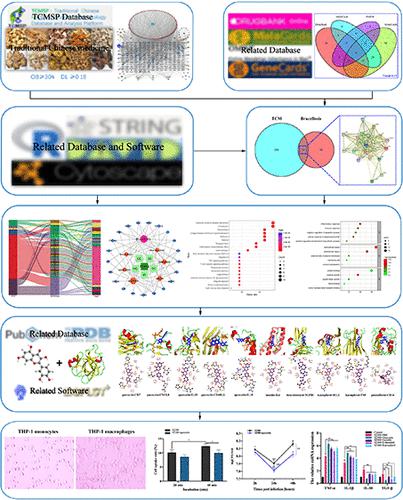Our official English website, www.x-mol.net, welcomes your
feedback! (Note: you will need to create a separate account there.)
Systemic Pharmacology Reveals the Potential Targets and Signaling Mechanisms in the Adjuvant Treatment of Brucellosis with Traditional Chinese Medicine
ACS Omega ( IF 3.7 ) Pub Date : 2023-07-28 , DOI: 10.1021/acsomega.3c03716 Tianyi Zhao 1 , Yu Zhang 1 , Liangbo Liu 1 , Xingmei Deng 1 , Jia Guo 1 , Shuzhu Cao 1 , Dexin Zhu 1 , Jian Xu 2 , Usevich Vera Nikolaevna 1, 3 , Suleimenov Maratbek 1, 4 , Zhen Wang 1 , Zhihua Sun 1 , Xinli Gu 1 , Hui Zhang 1
ACS Omega ( IF 3.7 ) Pub Date : 2023-07-28 , DOI: 10.1021/acsomega.3c03716 Tianyi Zhao 1 , Yu Zhang 1 , Liangbo Liu 1 , Xingmei Deng 1 , Jia Guo 1 , Shuzhu Cao 1 , Dexin Zhu 1 , Jian Xu 2 , Usevich Vera Nikolaevna 1, 3 , Suleimenov Maratbek 1, 4 , Zhen Wang 1 , Zhihua Sun 1 , Xinli Gu 1 , Hui Zhang 1
Affiliation

|
Human brucellosis is one of the world’s most common zoonoses, caused by Brucella infection and characterized by induced inflammation, which in severe cases can lead to abortion and sterility in humans and animals. There is growing evidence that traditional Chinese medicine (TCM) is beneficial as an adjunct to the treatment of brucellosis. However, its specific targets of action and molecular mechanisms remain unclear. In this study, a systematic pharmacological approach was applied to demonstrate pharmacological targets, biological functions, and signaling pathways of TCM as an adjunct to the treatment of brucellosis (TCMTB). The results of network pharmacology were further verified by in vitro experiments. Network analysis revealed that 133 active ingredients and 247 targets were screened in TCMTB. Further data analysis identified 21 core targets and 5 core compounds in TCMTB, including beta-sitosterol, quercetin, kaempferol, luteolin, and paeoniflorin. Gene ontology and the Kyoto Encyclopedia of Gene and Genome analysis showed that TCMTB might actively treat brucellosis by regulating inflammatory response, enhancing immune function, and targeting signaling pathways such as tuberculosis and TNF. Molecular docking results showed that multiple compounds could bind to multiple targets. Further, in vitro experiments confirmed that quercetin, among the active compounds screened, induced the strongest immunomodulatory and pro-inflammatory cytokine production during Brucella abortus infection. Further, quercetin induced nitric oxide production, which attenuated the ability of B. abortus to internalize THP-1 cells as well as intracellular survival. This study reveals the mechanism by which TCMTB aids in the treatment of brucellosis through a synergistic multicomponent, multipathway, and multitarget action. The contribution of quercetin treatment to B. abortus infection was demonstrated for the first time, which may be related to the quercetin-induced production of nitric oxide and immunomodulatory and inflammatory cytokines. These predictions of the core compounds and targets may be used in the future for the clinical treatment of brucellosis.
中文翻译:

系统药理学揭示中药辅助治疗布鲁氏菌病的潜在靶点和信号机制
人类布鲁氏菌病是世界上最常见的人畜共患病之一,由布鲁氏菌感染引起,其特征是诱发炎症,严重时可导致人类和动物流产和不育。越来越多的证据表明,中药 (TCM) 作为布鲁氏菌病的辅助治疗是有益的。然而,其具体作用靶点和分子机制仍不清楚。在这项研究中,采用系统的药理学方法来论证中药作为布鲁氏菌病(TCMTB)治疗辅助手段的药理学靶点、生物学功能和信号通路。网络药理学的结果通过体外实验进一步得到验证。网络分析显示,TCMTB中筛选出133个活性成分和247个靶标。进一步的数据分析确定了TCMTB中的21个核心靶点和5个核心化合物,包括β-谷甾醇、槲皮素、山奈酚、木犀草素和芍药苷。基因本体论以及京都基因和基因组百科全书分析表明,TCMTB可能通过调节炎症反应、增强免疫功能、靶向结核病和TNF等信号通路来积极治疗布鲁氏菌病。分子对接结果表明多种化合物可以与多个靶标结合。此外,体外实验证实,在筛选的活性化合物中,槲皮素在流产布鲁氏菌感染期间诱导最强的免疫调节和促炎细胞因子产生。此外,槲皮素诱导一氧化氮的产生,从而削弱了流产布鲁氏菌内化 THP-1 细胞的能力以及细胞内存活的能力。这项研究揭示了 TCMTB 通过多成分、多途径、多靶点的协同作用辅助治疗布鲁氏菌病的机制。首次证明槲皮素治疗对流产布鲁氏菌感染的作用,这可能与槲皮素诱导一氧化氮、免疫调节和炎症细胞因子的产生有关。这些对核心化合物和靶点的预测未来可能用于布鲁氏菌病的临床治疗。
更新日期:2023-07-28
中文翻译:

系统药理学揭示中药辅助治疗布鲁氏菌病的潜在靶点和信号机制
人类布鲁氏菌病是世界上最常见的人畜共患病之一,由布鲁氏菌感染引起,其特征是诱发炎症,严重时可导致人类和动物流产和不育。越来越多的证据表明,中药 (TCM) 作为布鲁氏菌病的辅助治疗是有益的。然而,其具体作用靶点和分子机制仍不清楚。在这项研究中,采用系统的药理学方法来论证中药作为布鲁氏菌病(TCMTB)治疗辅助手段的药理学靶点、生物学功能和信号通路。网络药理学的结果通过体外实验进一步得到验证。网络分析显示,TCMTB中筛选出133个活性成分和247个靶标。进一步的数据分析确定了TCMTB中的21个核心靶点和5个核心化合物,包括β-谷甾醇、槲皮素、山奈酚、木犀草素和芍药苷。基因本体论以及京都基因和基因组百科全书分析表明,TCMTB可能通过调节炎症反应、增强免疫功能、靶向结核病和TNF等信号通路来积极治疗布鲁氏菌病。分子对接结果表明多种化合物可以与多个靶标结合。此外,体外实验证实,在筛选的活性化合物中,槲皮素在流产布鲁氏菌感染期间诱导最强的免疫调节和促炎细胞因子产生。此外,槲皮素诱导一氧化氮的产生,从而削弱了流产布鲁氏菌内化 THP-1 细胞的能力以及细胞内存活的能力。这项研究揭示了 TCMTB 通过多成分、多途径、多靶点的协同作用辅助治疗布鲁氏菌病的机制。首次证明槲皮素治疗对流产布鲁氏菌感染的作用,这可能与槲皮素诱导一氧化氮、免疫调节和炎症细胞因子的产生有关。这些对核心化合物和靶点的预测未来可能用于布鲁氏菌病的临床治疗。






























 京公网安备 11010802027423号
京公网安备 11010802027423号